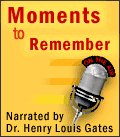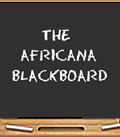Saturday June 27, 1969 was like any other Saturday night at New York City's Stonewall
bar. Eight plainclothes officers showed up that night, but the gay Greenwich Village
establishment was used to being raided by the police, as was every illegal club
in the city (particularly those frequented by gays
and heterosexual blacks and Latinos). At first the police just arrested Stonewall
employees for selling liquor without a license and allowed patrons to leave one
by one, which they did. But when several drag queens and a lesbian were roughly
shoved into the police wagon, something snapped inside the campy camp.
Pent-up anger at years of being entrapped and arrested by the police, of losing
jobs, families and homes because of prejudice, suddenly came bursting to the
surface. Someone picked up a coin and threw it, yelling "pigs!" Coins were replaced
by bottles, and, led in part by black and Latino drag queens, protestors battled
police in a spontaneous rebellion that in the following days attracted hundreds
of supporters, including many African Americans. This incident became the gay
equivalent to Rosa Parks' historic refusal to
give up her seat on the bus. "We shall endure," became "we shall overcome" and
a new movement was born.
Every year between May and September, gay communities across the globe take
to the streets to celebrate Gay Pride – a raucous, colorful commemoration of
the Stonewall riots. Amid the parades and blowout parties of the intervening
thirty years, Gay Pride has provided a rallying point for the struggle for gay
identity and civil rights.
And this struggle has largely been won. Witness the ever-evolving identities
– from homosexual, gay and lesbian, to the inclusion of bisexual and transgendered,
to the post-modern reclamation of derogatory terms such as "queer," "dyke" and
"faggot" and beyond; witness the progress on everything from domestic partner
policies in the workplace, to positive portrayals of queer folk in the media.
Witness the fact that South Africa, under the leadership of Mandela, was the
first country to provide protection for gays and lesbians in its constitution.
Queer folk are an increasingly enfranchised minority, prompting many to question
the relevance of Gay Pride by asking "proud of what?" Can't we all just wave
a rainbow flag and get along?
For many black gays and lesbians, however, the rainbow is not enuf. Beset by
racism in the larger society (and in the gay community) and homophobia in the
black community, black queers are forced to forge support networks of their
own or fall through the cracks.
Gay Men of African Descent (GMAD) is one such outlet. Located in New York City's
West Village, the organization hosts Happy Hours, a Seniors' Program, various
HIV- and AIDS-related programs, and other activities. The men who walk through
GMAD's doors are as diverse as the shades of black people's skin. There are
b-boys, spectacled intellectuals and baggy-eyed seniors; they could be your
father, your grandfather or brother. And, actually, they are.
"I think the challenge for me as a black man who is same-gender-loving is to
show people that I still am a man," says Kevin Green, a black writer in his
thirties. "I still identify as a man. As much as I love my sisters, as much
as I love their feminineness, I don't want to be them."
Of course, black gay men and women come in all flavors. At one extreme, you
have your RuPaul drag queens – feminine as they
are fierce – and tuxedoed, male-impersonating lesbians. At the other end of
the spectrum are your garden variety Homo Thugs. Yes, there are black gays who
completely embrace gangsta rap-style thug life. Between these two extremes exists
the vast and varied continuum of, well, just folks.
"We have so many stories," says Steven G. Fullwood, a 34-year-old freelance
writer who also works for GMAD. Fullwood explored his experience as a gay man
in an article titled "I Was a Teenage Sissy,"
sharing one individual perspective on gay identity and the challenges it posed
for him. "I grapple with masculine identity as both something I shun and also
something I want to embrace."
The pressure to conform to idealized images within the black community often
forces alternative lifestyles and sexualities underground. Historically, however,
this hasn't always been the case.During the Harlem Renaissance black gays and lesbians were quite open about
their proclivities. There were drag balls at Rockland Palace. There was A'Lelia
Walker's (Madam CJ Walker's daughter) Dark Tower, which was notoriously frequented
by queer folk. There was Niggerati Manor on 136th Street, a bohemian
boardinghouse for black artists where bright phalluses were painted on the walls.
There were clubs, smoky speakeasies and dives. According to Geraldine Dorismond,
a prominent society writer for the Amsterdam News and the Interstate
Tattler, black gays and lesbians threw the best parties, which she attended
and wrote about. This casual acceptance of gay life in straight society pages
is almost unheard of today.
Michael Henry Adams, a black gay historical preservationist, has made it his
project to unearth what he calls "homo Harlem." Having interviewed countless
gay men and women who lived in Harlem during its gay heyday (from the Renaissance
through the 1950's), Adams himself has become a walking, talking font of black
queer history.
There are stories about the black actress who lived not only with her husband,
but also her devoted British female companion. There are stories about the famous
black crooner who was one of their tenants and the prominent white architect
that became his lover. Of course there are tales, both written and oral, of
the decadent, well-attended parties. According to Adams, to be gay and successful
or gay, young and attractive at that time was to be admitted into "a kind of
international secret society." This society was moneyed, well educated, intensely
creative and nothing short of fabulous.
"It was exhilarating to discover that some of the most important figures of
the Harlem Renaissance were lesbian and gay," says Adams, who remembers being
taught in high school to revere writers such as Langston Hughes and Countee
Cullen, whom many gay activists have more recently claimed as gay icons. "And
then to find that the most outstanding people were gay, lesbian or bisexual
was a coup."
For Adams, his research is a means to combat homophobia in the black community
"Perhaps I'm naïve," he says, "but I hope that when people see that many
of their heroes and sheroes were gay and lesbian they'll stop and think."
Norman, a 59-year-old gay educator who declined to give his full name in order
to protect his job, has a lot to say about the importance of history. "I love
life, I always have," he says, leaning forward dramatically with a smile. During
his lifetime, Norman has witnessed decades of black queer history, from the
vibrant, gay thoroughfare in Queens (a 20-block street inhabited by black gay
people), through the decimation of 80% of the community due to AIDS, through
narcissistic 90s and into the flurry of 2K. Noting that he is a lucky survivor,
like any elder, Norman feels compelled to pass on his knowledge.
"I feel so blessed just to be here," he says. In regards to black, gay youth,
however, he grows despairing. "A lot of these children today don't have the
energy that we had. I tell kids in the classroom that they have the power to
change things, but they're not interested. Black gay kids assume that [gay rights]
have always been there. But we fought for those things. All of them assume that
all the bridges have been crossed and that there are no other bridges that need
crossing. The gay kids in my life, I try to get them to go back to school, to
read and to do all the things that were paramount to me becoming the man that
I am."
Ronald Walker, the 60-year-old Senior's Program Coordinator for GMAD, echoes
Norman's concerns. He is less alarmed however, remembering the time when he
too was caught up in the posturing and the party life.
"One of the advantages of being older is that I feel like I am out of the race,"
he says softly, leaning back in his chair. "I can almost say anything that I
feel like. I don't really have to impress anybody, and I mean that in a good
way. It's really freed me up. I hope that the young men will realize that they
will one day be our age and that there is life after 35. It gets easier and
easier."
As black gays and lesbians reflect on the meaning of pride, it is clear that
there is still work to be done. While AIDS continues to disproportionately affect
African Americans, both gay and straight alike, homophobia has made the community
slow to respond to the crisis.
Still, many black gays are optimistic about their quest for acceptance. Kevin
Green sees it this way. "As long as I stand fast or, as they say in the black
church, as long as I hold up the blood-stained banner, then [straight people]
get to see my humanity. And as they see and experience my humanity, they get
past my sexuality."
Today's article is the first in a continuing series on sexuality and relationships
in the worldwide Africana community.




